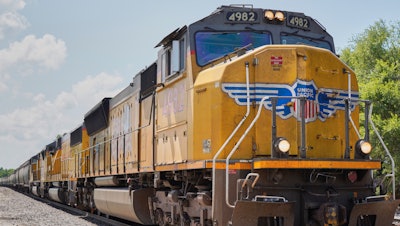
OMAHA, Neb. (AP) — Union Pacific's latest attempt to move toward cutting its train crews down to one person remains on hold because of the longstanding safety concerns of the union that represents conductors.
The railroad had wanted to start a pilot project this year in the western end of its home state of Nebraska to test out how quickly a conductor based in a truck could respond to train problems and compare that to how fast the conductor aboard the train could address them.
But the Transportation Division of the International Association of Sheet Metal, Air, Rail and Transportation Workers union refused to agree to the plan because it believes train conductors play a crucial safety role.
UP executives told the Federal Railroad Administration that their plan would have helped them determine how feasible it would be to reduce train crews down to just an engineer and might give the agency valuable information to consider as it weighs whether to issue a rule requiring two-person crews.
The pilot program wouldn't have actually reduced the train crew down to one because Union Pacific would have kept conductors on their trains while adding ground-based conductors to test out their response.
Union Pacific has been undaunted in pursuing one-person crews even after the FRA proposed a rule last summer that would require two people in the cab of a locomotive in most circumstances. The railroad argues that modern technology — particularly the automatic braking system railroads were required to install in recent years — makes the conductor unnecessary on a train and executives believe that moving conductors off of trains would improve their quality of life by giving them more predictable schedules and keeping them from going on the road.
UP spokeswoman Kristen South said the railroad can't move forward with its plan "without it being agreed upon through collective bargaining."
The union confirmed in a letter that no such agreement has been reached.
The SMART-TD union has long opposed moving conductors out of locomotives, arguing they help monitor track conditions and radio communications while ensuring that engineers remain alert and respond to any emergencies or mechanical problems on the train. In the case of a derailment or collision, conductors are the first ones to respond before any additional help can arrive.
SMART-TD President Jeremy Ferguson urged regulators to approve their proposed rule requiring two-person crews at a hearing last month because "conductors are observing track conditions while engineers are obligated to split their attention between monitoring the controls and the track. Having conductors on trains saves lives, and prevents disasters in ways technology cannot. Artificial intelligence absolutely has a role to play, but it cannot replace authentic human intelligence in railroading."
One of the most striking examples of the benefit of having a conductor on board came during a fiery 2013 derailment near Casselton, North Dakota, when the conductor was able to help separate undamaged tank cars filled with crude oil from the rest of the train so they could be pulled away from the fire.
Ferguson also cited an example of a time when a conductor was able to get a young boy off the tracks before the train hit him by stepping out on the front of the locomotive and waving him away.
But the railroad's spokeswoman, South, said "a conductor's job primarily consists of preparing a train for departure and addressing mechanical issues that occur on a route." And UP believes those duties could be best handled by someone based on the ground who responds to any problems within a certain territory. The railroad even created a video touting their idea.
In addition to the safety concerns, the union also raises practical questions about whether a conductor driving a truck would even be able to reach a train in remote locations where no roads are near the tracks. Plus, a conductor in a truck could easily get delayed in traffic.
In the western Nebraska location where UP wanted to start testing its idea, those concerns wouldn't come into play much because the area is rural and a major highway runs right along the tracks. The job of a ground-based conductor would get more complicated in mountainous terrain or urban areas with heavy traffic around the tracks. UP had planned to test its concept in those kind of areas later.






















